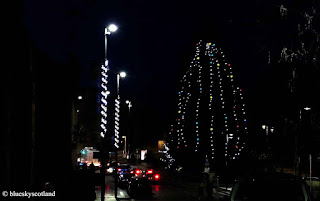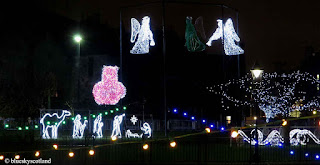ALL PHOTOS CLICK FULL SCREEN.
This is a post from the autumn months just past. It's been 20 years since I did any rock climbing but having visited Dumbarton Rock in the summer for a spot of youthful nostalgia I was curious to see how the climbing crag of Craigmore was getting on. See photo above for the crag and note the large pine tree on the left with an obvious deep crack below it. This is Craigmore Corner. 42 feet high or 13metres. 5b HVS.
A closer look at it from below. It is the classic route of this crag and as there are no holds to speak of until you reach the obvious square block jutting out, around 20 foot up, it requires strenuous, (legs and arms wide apart), bridging until you reach this point and grab the first good hold. Hard Very Severe was the upper limit of my climbing potential in my prime and I only managed to get up this tricky bugger once. Imagine back and footing or bridging up a smooth concrete corner of a large warehouse building for 20 feet, moving upwards a painstaking twelve inches at a time with each foot, only kept in place by maximum pressure exerted to maintain friction on all four limbs splayed out at once, starfish fashion, and you get some idea of the effort involved. When I made it to the top of the route I was so exhausted it took me ages to get the strength back in my arms and fingers to untie the rope. I made a lot of noise apparently, grunting and straining with every move but I was also elated. This was a route I'd walked past many times over a ten year period, attempted it at least five times and only succeeded at last after giving it full 110% commitment. Unless you are a very good technical climber or have gymnastic ability and love bridging it is an immense struggle and I was in no rush to repeat it once I'd achieved my prize. That single ascent was enough.
Another look at Craigmore Corner. 5b. HVS. Tom and Jerry Wall. 13metres. 5a. and Rampage 16 metres 4b VS. Both lie to the right of CC. All starred routes of quality in my old guide book. I mention this as Craigmore lies just north of Glasgow and Bearsden, is 30 mins away or less in the car, and was one of the more popular local climbing crags in the Central Belt with a dozen or more starred enjoyable routes. My climbing club used to go here nights and sunny weekends every summer for over a decade but looking at the crag close up I did not notice much evidence of chalk marks. With all the indoor climbing walls around I don't know if outdoor climbing on local crags is still as popular as it used to be. Or maybe with a lack of local crag climbers nesting birds are more of a problem these days? I did visit around 10 years ago and the crag then looked more mossy and vegetated than it looks today but it's hard to tell with just two visits years apart and no one around to ask.
A view from the top of the routes. It is easy to get to however, with great views of the surrounding Campsie Fells, a four car layby spot not far away, and a nice landscape feature. It was a beautiful sunny Sunday after a long dry summer so I half expected to see some current generation rock climbers or bouldering folk around but just like the last time I visited, it remained deserted yet nesting birds should only be a problem in the spring/ early summer.
Being deserted was handy in one sense in that no-one was around to see how ungainly I've become as I clambered over uneven ground like a human elephant seal to get to the base of this long line of crags over a jumble of fallen rocks. Thick summer vegetation, several deep hidden holes, and a lack of well trampled paths was another indication this place might not get the foot traffic it once did in my heyday 30 years ago. The above dotted route is Autobahn 10 metres 5a and another classic. I always got up this one as it does have holds and is a beautiful, delicate dance sequence of precise movements on a vertical chessboard instead of Craigmore Corner's brutal thrutch of a route using sheer power. This one was a favourite and an elegant pleasure to ascend every time.
Rock climbs definitely have their own unique personality. The first a macho great ape glaring down at you with malice and intent, silently willing you to retreat backwards to ground level with every shaky move taken upwards.... feeling like invisible fingers pushing on your head, .... which is merely the effect of gravity of course, but a fearsome presence on every inch of this route to the block, given the lack of positive holds. Autobahn, by contrast, was always a delicate European chanteuse anytime I met her, one that could be coaxed to smile and even lend a slender helping hand upwards with the correct polite approach. A much repeated, lighter than air, joy.
Another place we climbed in those days was Loudoun Hill but that was a volcanic plug of rock near Darvel in Ayrshire so not as handy or as easy to get to from North Glasgow although it did have a wide range of routes in a pleasant rural setting. The highest climbs on this crag felt like proper mountain routes. This one above is Brian on The Edge VS. 45 metres long or 148 feet high. The classic route on the crag and an eye-catching wonder as it takes the boldest line up a sharp thin arete. I wasn't planing on climbing this but after Brian had done the hard part by leading it I grabbed my chance to second it. Another memorable climb ticked off. This is the middle section up the dramatic, and to all outward appearances, barely attached, fin. There is a bottom tier of rock below this one so it feels airy and committing.
Looking across from Craigmore Crag at the wooded slopes of Mugdock Country Park.
Rolling pastureland.
Dumgoyne and the Campsie fells from the walk into the crag.
A different view of it from the ridge line. Just being up here again is a pleasure.
Another view of Craigmore Corner and the belay tree.
View looking East from the top of the crag.
A small wooded hill near the West Highland Way long distance footpath.
The belay sling at the top of Craigmore Corner. I would always put my own sling round the tree as well, just to be on the safe side and use both rather than trust old gear left out in the elements. You can always retrieve your own gear after climbing the route
The beauty of Scotland in late August.
On the same day I also visited another favourite rock climbing venue just a ten minute drive from Craigmore. Family favourite The Whangie which is a deep cleft in the rock caused by 'glacial puckering', as in a large mass of ice 'sucking' the rock apart along a fault line to create a dry chasm you can walk through. A geological oddity popular with children... and adults.
Walking through the cleft at The Whangie.
This has also produced, on the north facing outer side, a small line of cliffs where rock climbing still takes place. The infamous Ivy Crack 10 metres. Severe. Backstep Chimney. 12 metres. Severe. and Backbreak Wall 13 metres VS 4c. Also Horror Route at E1. As the rock tends to be loose near the upper edges top roping is advised for this crag as accidents have occurred.
View looking north and east from The Whangie with the village of Killearn visible. A pleasant outing and a glimpse of a more youthful me I hardly identify with anymore. I suppose everyone feels like that about their past days self, looking back as almost belonging to a different person.
Purple heather walking across the Kilpatrick's flat plateau.
Free standing railway pillar attempt. Where once upon a time climbing ambition soared upwards with few boundaries...
and even skyscraper rock towers like this one failed to dim our enthusiasm for what we always assumed was achievable...
(The Toenail Traverse. Hard Severe climb in Wales. No handholds at all just balance and nifty footwork edging slowly along a two inch wide ledge....) A slightly deceptive photo as the ground is a long way below on a multi pitch route. Nowadays I might stumble over foot high boulders or embarrassingly falter at fences or other sundry Grandad stoppers I used to leap over without consciously thinking about it and I just shudder my way past vertical walls now with no intention of ever going up them....
Oh, how the once mighty bodies crumble with age...
Vertical Railway Wall Practice in Glasgow.... good for increasing toe, leg, and finger strength apparently. Training 1980s style.
Watched a good You Tube video recently. No rent, a tent, and a camera: Backpacking Britain.
An enjoyable mini film of a solo trip down the length of the UK, end to end, that reminded me strongly of my first adventures as a teenager, venturing off alone into the wilds with a tent.


































































